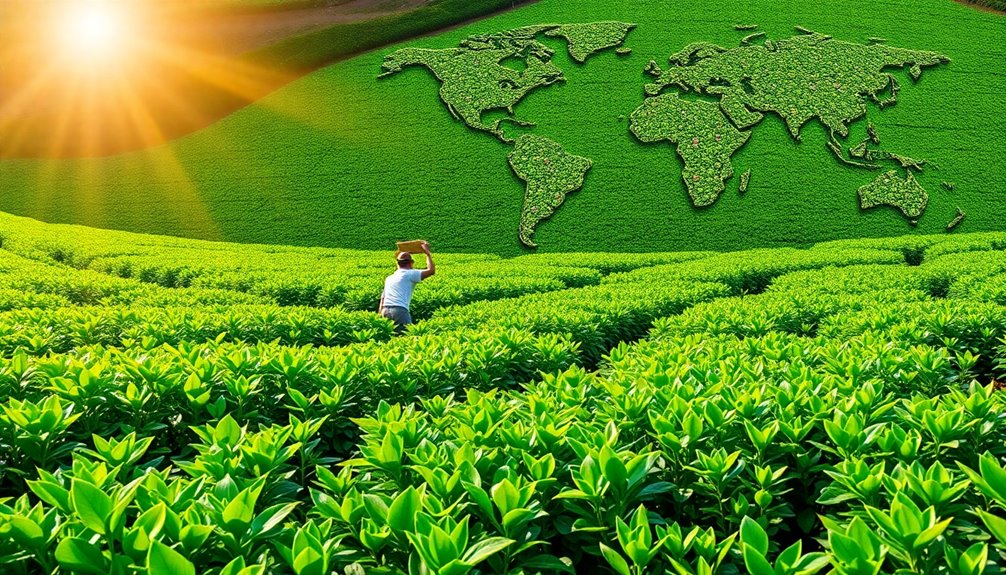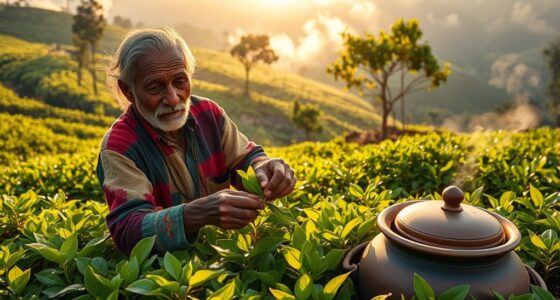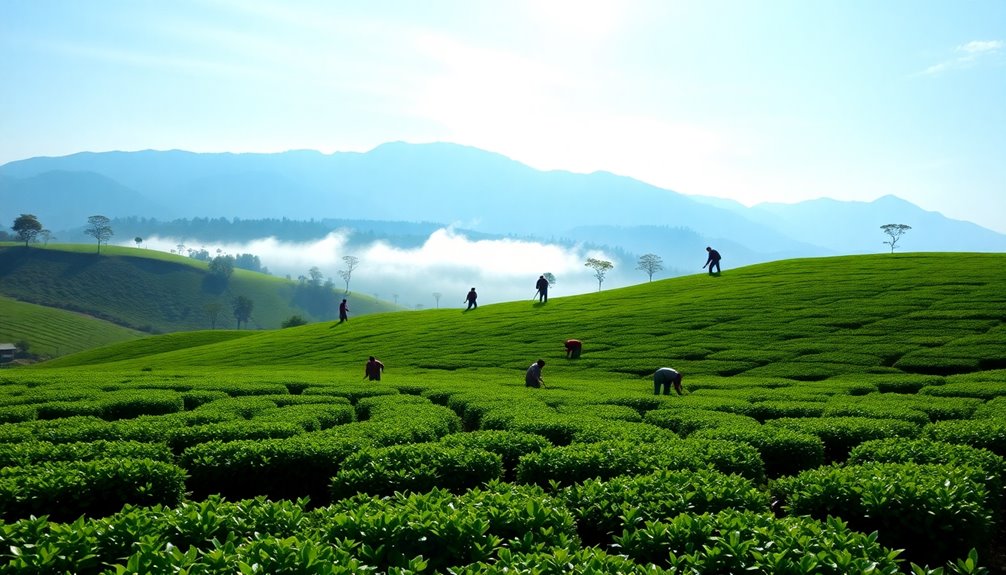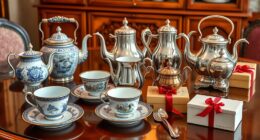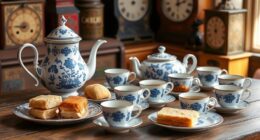The economics of India's tea industry is exciting and vital! You'll find over 13,000 tea gardens, employing around 2 million hard-working folks. With a production of 1,344.4 million kg in 2021-22, India's tea is loved at home, with about 80% consumed locally. Did you know India is the second-largest tea producer globally? That's impressive! The country focuses on quality and sustainable farming, with many gardens adopting organic practices. Plus, boosting labor rights is key for workers' futures. If you're curious about all the sweet details, there's so much more to discover about this delightful industry!
Key Takeaways
- India is the second-largest tea producer globally, contributing to about 10% of worldwide tea exports, valued at US$ 776 million in 2023-24.
- Approximately 80% of the tea produced in India is consumed domestically, highlighting its vital role in the local economy.
- The tea industry employs around 2 million workers, facing challenges such as wage disparities and poor working conditions, particularly in Assam.
- Sustainable farming practices, including organic certification and integrated pest management, are increasingly adopted to enhance ecological health and product quality.
- Competition from countries like Kenya and Sri Lanka poses challenges to export growth, necessitating a focus on quality assurance to maintain market share.
Introduction

The Indian tea industry, with its rich history spanning over 172 years, is a vital part of the nation's economy. You'll find over 13,000 tea gardens across India, each buzzing with the activity of around 2 million workers. Together, they create a magical world of tea that many love to enjoy.
In the fiscal year 2021-22, India produced an impressive 1,344.4 million kg of tea! Surprisingly, about 80% of this production is enjoyed right here at home.
India stands tall as the second-largest tea producer in the world, holding a 10% share of global tea exports from India, valued at a whopping US$ 750.63 million. Most of these exports consist of delicious black tea, loved by many around the globe.
However, the Indian tea industry faces challenges like changing prices, labor concerns, and the impacts of climate change. These issues can affect how much tea is produced and how profitable it's for growers.
Yet, there's a silver lining! Recent trends show that people are excited about innovative, sustainable, and unique tea varieties, leading to a growing demand for both domestic consumption and exports.
Global Tea Consumption Trends
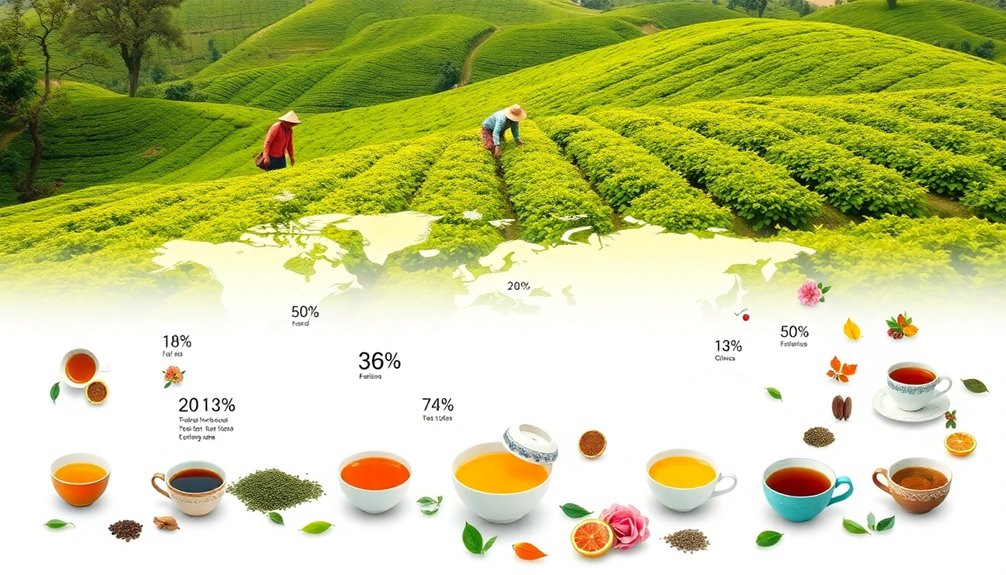
As the Indian tea industry thrives with innovative offerings, global consumption trends are also evolving rapidly. You might be surprised to learn that in 2022, people drank about 6 million metric tons of tea! Most of it—around 75%—was black tea, a favorite for many families.
However, there's been a delightful shift in tea consumption, with more folks turning to green tea and herbal infusions. These healthier options are becoming popular, especially among those who enjoy the benefits of a wellness-focused lifestyle.
Did you know that the Asia-Pacific region is the largest tea consumer? India and China together make up over 50% of the world's tea consumption! This means that every time you sip your cup of chai, you're part of a huge global community.
What's even more exciting is how e-commerce is changing the way you can buy tea. Now, you can explore a vast variety of specialty teas right from your home.
With tasty new flavors and convenient ready-to-drink options, there's never been a better time to enjoy your favorite brew! So, grab a cup and join the joyful tea celebration!
Export Growth Rates Fluctuate

India's tea exports play a significant role in the global market, accounting for 10% of total tea exports with a value of US$ 776 million in 2023-24.
It's exciting to see how Indian tea has made its mark, especially with black tea making up a whopping 96% of exports! Recently, you've probably heard about the amazing growth rates in specific markets like the USA, Russia, and UAE. For instance, the export of Indian tea to the USA jumped by 89% in 2022-23. That's fantastic news!
However, while some regions are thriving, overall export growth rates have faced ups and downs since 2016. This fluctuation is mainly due to tough competition from countries like Kenya and Sri Lanka.
To keep up, it's essential to focus on the quality of tea production. In 2023-24, the unit price of Indian tea was about US$ 3.10 per kg. This tells us there's a big opportunity to improve quality assurance and branding.
Sustainable Farming Practices Emerging
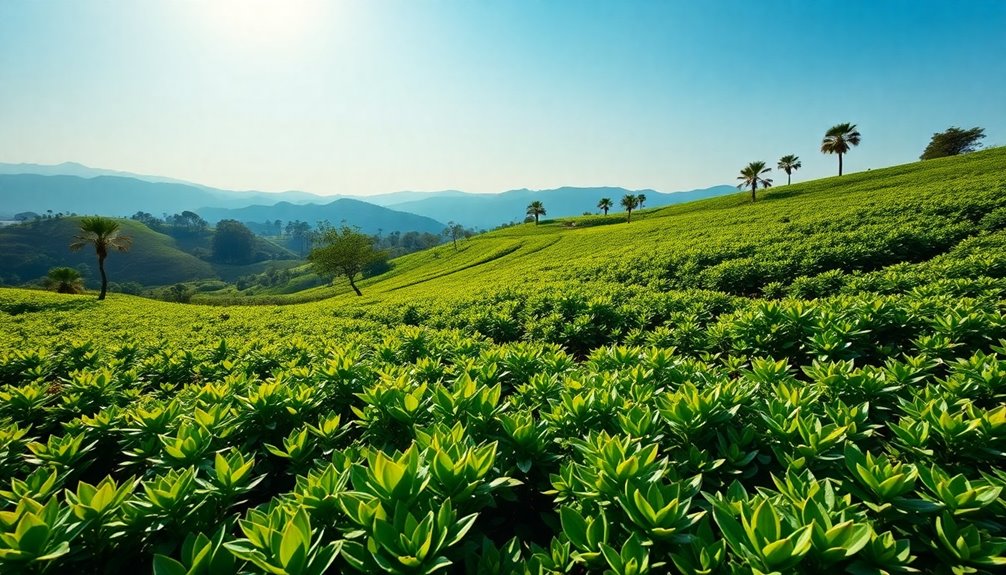
Sustainable farming practices are increasingly taking root within the tea industry, transforming how producers cultivate their crops.
You'll be happy to know that over 15% of tea gardens in India are now certified organic! This means that farmers are using organic methods to grow tea, which helps reduce chemicals and promotes a healthier environment.
Here are some exciting practices being adopted:
- Integrated Pest Management (IPM): This technique helps reduce the need for synthetic pesticides, leading to healthier ecosystems and better tea quality.
- Water Conservation: Farmers are using rainwater harvesting and drip irrigation to combat climate challenges, ensuring they've enough water for their crops.
- Agroforestry Systems: Tea isn't just grown alone anymore! Farmers are planting native trees alongside tea bushes, which not only improves soil health but also provides extra income from timber and other products.
The Indian government supports these sustainable farming practices, encouraging small growers to join in.
Labor Rights Issues
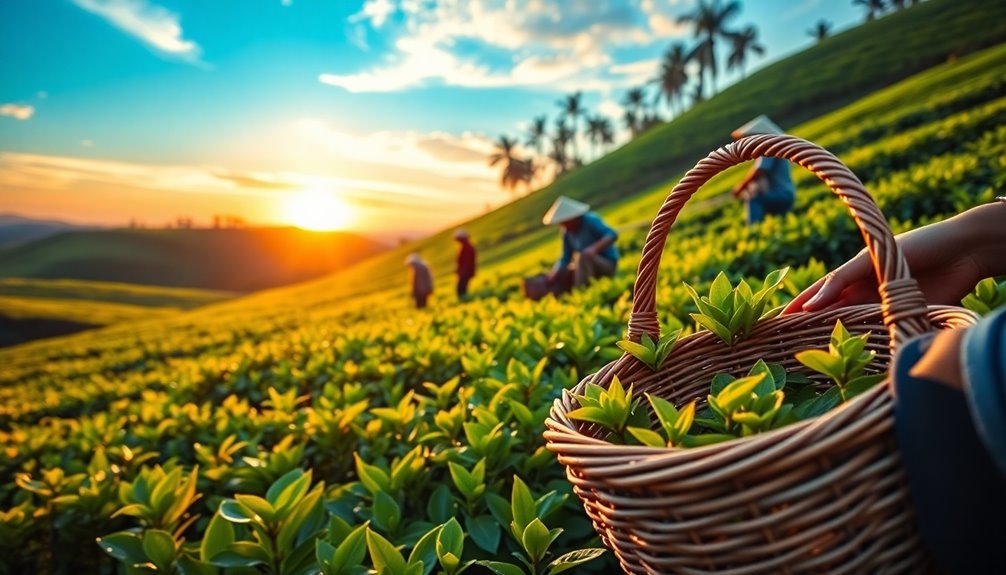
In the shadows of India's thriving tea industry, labor rights issues remain a pressing concern. While tea is a beloved beverage enjoyed by many, the workers who harvest it often face tough challenges. In Assam, for instance, many workers earn less than the minimum wage, and this is due to a lack of action from the state government.
- Wage Disparities: Workers in Assam's Barak Valley earn less than those in the Brahmaputra Valley, creating unfair pay differences.
- Employment Numbers: About 2 million workers are part of the tea industry in India, yet many struggle with low incomes and limited education.
- Poor Conditions: The Assam Tea Corporation gardens are particularly known for their harsh working conditions, making life difficult for workers.
These issues are serious because they affect not just the workers but also their families and communities.
Everyone deserves fair treatment and a chance to thrive! Addressing labor rights is essential for creating a better future for Assam's tea workers and ensuring that the tea industry can continue to flourish.
Together, we can hope for a brighter tomorrow for everyone involved!
Practical Applications

The tea industry in India offers numerous practical applications that can enhance both productivity and worker welfare.
You can imagine the bustling tea gardens, where workers carefully pluck fresh leaves, ready to be turned into delicious tea. With the Indian Tea Association's support, many tea producers are using new marketing strategies to promote packaged tea. This makes it easier for you to enjoy your favorite brews at home.
Here are some exciting facts about the tea industry:
- India produced about 1,382.03 million kg of tea in the last year, showing a stable trend.
- Black tea makes up an impressive 96% of total tea exports, contributing to a whopping US$ 776 million in export value for 2023-24.
- Major markets for Indian tea include the UAE, Iraq, and the USA, with exports to the UAE growing by 195%.
These steps help boost local economies and ensure workers are treated fairly.
Frequently Asked Questions
What Is the Economy of Tea in India?
The economy of tea in India's vibrant, with significant production and consumption. You'll find it employs millions, supports rural livelihoods, and faces challenges like price fluctuations and climate change that affect sustainability and profitability.
What Is the Financial Performance of Tea Industry in India?
The financial performance of India's tea industry shows steady growth, with production rising and strong domestic consumption. However, you'll notice challenges like fluctuating prices and rising costs, highlighting the need for innovation and modernization.
How Big Is the Tea Industry in India?
You'll find India's tea industry is vast, covering around 6.19 lakh hectares. It produces approximately 1,382 million kg annually, making it a significant player in the global tea market and a staple for domestic consumption.
How Much Is the Tea Industry Worth in India?
You'll find that India's tea industry is worth about US$ 750.63 million in exports for FY 2021-22. With substantial production and global demand, its value continues to grow, making it a vital sector.
Conclusion
In conclusion, India's tea industry is a vibrant part of our world, bringing joy to tea lovers everywhere! As we sip our favorite brews, let's celebrate the hardworking farmers and the beautiful landscapes where tea grows. Remember, choosing sustainable teas helps protect the environment and support fair labor practices. So, next time you enjoy a cup of tea with family and friends, you're not just tasting something delicious; you're also making a positive impact. Cheers to that!


